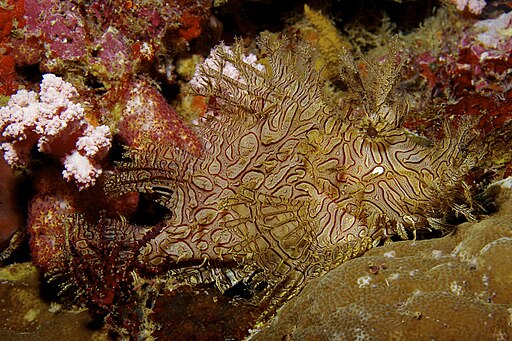Superregnum: Eukaryota
Cladus: Unikonta
Cladus: Opisthokonta
Cladus: Holozoa
Regnum: Animalia
Subregnum: Eumetazoa
Cladus: Bilateria
Cladus: Nephrozoa
Superphylum: Deuterostomia
Phylum: Chordata
Subphylum: Vertebrata
Infraphylum: Gnathostomata
Megaclassis: Osteichthyes
Superclassis/Classis: Actinopterygii
Classis/Subclassis: Actinopteri
Subclassis/Infraclassis: Neopterygii
Infraclassis: Teleostei
Megacohors: Osteoglossocephalai
Supercohors: Clupeocephala
Cohors: Euteleosteomorpha
Subcohors: Neoteleostei
Infracohors: Eurypterygia
Sectio: Ctenosquamata
Subsectio: Acanthomorphata
Divisio/Superordo: Acanthopterygii
Ordo: Scorpaeniformes
Subordo: Scorpaenoidei
Familia: Scorpaenidae
Subfamilia: Scorpaeninae
Genus: Rhinopias
Species: Rhinopias aphanes
Rhinopias aphanes, the lacy scorpionfish, weedy scorpionfish or Merlet's scorpionfish, is a species of marine ray-finned fish belonging to the family Scorpaenidae, the scorpionfishes. This species is found in the Western Pacific. It occasionally makes its way into the aquarium trade.
Taxonomy
Rhinopias aphanes was first formally described in 1973 by the American ichthyologist William N. Eschmeyer with the type locality given as New Caledonia.[2] The specific name aphanes means "that which is unseen or inconspicuous", an allusion to the camouflage created by its notable coloration and flaps of skin.[3]
Description
Rhinopias aphanes has two black spots in the middle of the membrane between the sixth and eighth rays in the dorsal fin, and these spots are absent in R. argoliba, R. cea and R. xenops; by the lack of scales on the operculum between the tips of the upper and lower opercular spines and the opercular margin, whereas in the other three species scales are present; and in having 16 or 17 pectoral-fin rays compared to 18. It can be separated from R. eschmeyeri and R.frondosa by the spiny part of the dorsal fin having non fleshy membranes while on the other two species these are fleshy, the margins of the soft-rayed portions of the dorsal, pelvic, anal, and caudal fins clearly notched, as opposed to unnotched or wekly notched, and the tips of each caudal fin ray have two brebnches in adults and are not branched in juveniles, compared to four branches, the dorsal fin spines are rigid with strongly pointed tips, in the other two they are relatively soft and tips bend readily if on ly a little pressure is applied; he lateral lacrimal spine is pointed while in the other two it nmay be absent or vestigial; the suborbital ridge typically has three pointed spines, in R. eschmeyeri and R. frondosa these are usually just three bumps; the two black spots on the soft-rayed part of the dorsal fin are normally greater than diameter of the orbit diameter, while in the other two species there are one or two spots which are typically than the diameter of the orbit. This species has an elongated black-edged white markings each with a central are which may be yellow, green, or brown, rarely purplis, in colour in life. There are 12–18 tentacles underneath the lower jaw, 2-4 tebntacles below the eyes and many tentacles on the flanks above the lateral line. There are clearly branched, long tentacles on the supraocular and rear lacrimal spines.[4] This species grows to a total length of 25 centimetres (9.8 in).[5]
On the Great Barrier Reef, Queensland
Distribution and habitat
Rhinopias aphanes occurs in the western Pacific where it has been recorded from Queensland, Papua New Guinea, New Caledonia, and Vanuatu. It is found at depths between 5 and 30 m (16 and 98 ft).[1] This is a rare species found on coral slope and soft substrates. It is a benthic fish, which rests on the seabed.[6]
Biology
Rhinopias aphanes has been observed that they are very reluctant to leave the bottom and rarely swim, they are more active at night. Rather, they locomote using walking and hopping-like movements using their pelvic and pectoral fins. The prey of Rhinopias aphanes consists of small fish. These fish lie on the bottom and rock gently back and forth and from side to side. Water is expelled through branchial tubes above the operculum which moves the tentacles present on the first few soft rays of the dorsal fin to quiver. This movement improves the canouflage and resembles algae or benthic invertebrates swaying in the current.[6]
Utilisation
Rhinopias aphanes is a much sought after fish in the aquarium trade.[1]
See also
List of marine aquarium fish species
References
Motomura, H.; Matsuura, K. (2016). "Rhinopias aphanes". IUCN Red List of Threatened Species. 2016: e.T69800178A69801042. doi:10.2305/IUCN.UK.2016-3.RLTS.T69800178A69801042.en. Retrieved 18 November 2021.
Eschmeyer, William N.; Fricke, Ron & van der Laan, Richard (eds.). "Species in the genus Rhinopias". Catalog of Fishes. California Academy of Sciences. Retrieved 30 January 2021.
Christopher Scharpf & Kenneth J. Lazara, eds. (2 October 2021). "Order Perciformes (Part 9): Suborder Scorpaenoidei: Family Scorpaenidae". The ETYFish Project Fish Name Etymology Database. Christopher Scharpf and Kenneth J. Lazara. Retrieved 30 January 2022.
Motomura, Hiroyuki and Johnson, Jeff (2006). "Validity of the Poorly Known Scorpionfish, Rhinopias eschmeyeri, with Redescriptions of R. frondosa and R. aphanes (Scorpaeniformes: Scorpaenidae)". Copeia. 2006: 500–515. doi:10.1643/0045-8511(2006)2006[500:VOTPKS]2.0.CO;2.
Froese, Rainer; Pauly, Daniel (eds.) (2021). "Rhinopias aphanes" in FishBase. Augsut 2021 version.
Dinesen, Zena. D.; Warwich J. Nash (1982). "The Scorpionfish Rhinopias aphanes Eschmeyer from Australia". Japanese Journal of Ichthyology. 29 (2): 179–184. Retrieved 30 January 2022.
Retrieved from "http://en.wikipedia.org/"
All text is available under the terms of the GNU Free Documentation License


